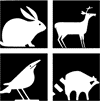Wildlife Damage Management, Internet Center for
Date of this Version
2003
Document Type
Article
Abstract
The white-tailed deer (Odocoileus virginianus) may cause more damage than any other wildlife species. Deer damage occurs in various forms including crop production, automobile accidents, aviation collisions on runways, disease transmission, degradation of natural ecosystems, and destruction of ornamental plantings. One practical method of controlling deer damage is through the use of exclusionary fencing. White-tailed deer are challenging to exclude as they are able to jump 3.0-m fences or fit through spaces > 20 cm wide. Some deer problems (disease outbreaks, aircraft runways, and busy highways in deer migration corridors) may necessitate the installation of effective fencing no matter what the cost. Fences most often installed to control white-tailed deer damage include, but are not limited to, many varieties and types of wire mesh, plastic mesh, high-tensile steel wire, and electric fence. We have reviewed scientific literature on fencing to compare fence designs and methods to predict which are best suited for excluding deer under a variety of conditions.
In situations where a nearly impenetrable, low maintenance, long-life fence is needed, a 3.0-3.64 m-high wire mesh fence is the best option. If complete exclusion is not a necessity and fence cost is an issue, a multi-strand, electrified, high-tensile steel wire fence may be sufficient. For seasonal protection, an affordable, easily installed, peanut butter fence may be adequate. Each fencing application will require consideration of different factors for determining the most appropriate fence, requiring a thorough comparison of available options to assist in the decision making process.
The most important considerations for determining the best fence for a specific application include: level of protection desired from the fence, deer’s ability to penetrate different fence designs, motivation to penetrate a fence, costs associated with a fence, and possible negative effects of erecting a fence. Fencing may be only part of the answer to a deer damage issue. An integrated management approach may increase the overall efficacy of any individual damage reduction method, including fencing.
With abundant white-tailed deer populations, recent disease outbreaks, increasing vehicle collisions, and increased urbanization, there is an increasing need for effective deer-damage management tools. There are many research needs in the area of wildlife exclusion. Few rigorous tests of the efficacy of different fence designs have been conducted. Efficacy levels of any specific fence design are difficult to establish due to the multitude of interacting variables determining how an animal will respond to a particular fence design. Most, if not all, of the scientific testing conducted to date has been directed at excluding animals. However, means of confining captive deer are also of importance.



Comments
Published in Proceedings of the 10th Wildlife Damage Management Conference. (K.A. Fagerstone, G.W. Witmer, Eds). 2003